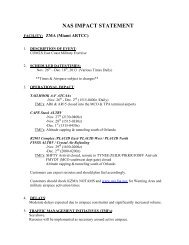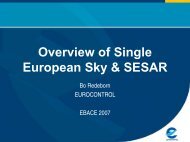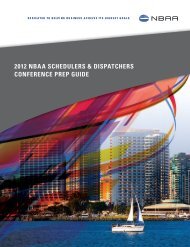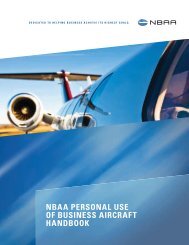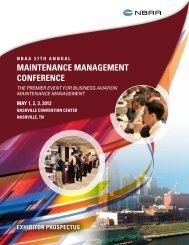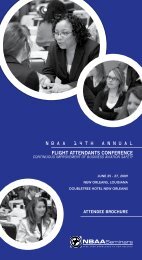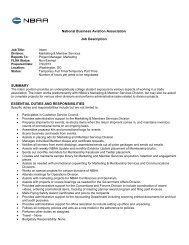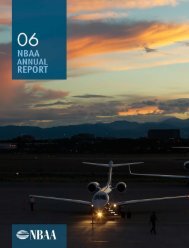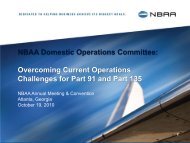Travel$ense User's Guide (PDF, 139 MB) - NBAA
Travel$ense User's Guide (PDF, 139 MB) - NBAA
Travel$ense User's Guide (PDF, 139 MB) - NBAA
- No tags were found...
Create successful ePaper yourself
Turn your PDF publications into a flip-book with our unique Google optimized e-Paper software.
138TRAVEL$ENSEProductivity enroute also is considered by <strong>Travel$ense</strong>. Personal productivity isvariable, which isn’t easily trackable. Average productivity is estimable, calculableand environment-dependent. The potential productivity on publictransportation is limited, particularly for groups and acutely for seniormanagement carrying sensitive information. The bottom line is that it is difficultto conduct business effectively – to be substantially productive – in public.The big question: do your company’s current travel policies proactivelymaximize employee productivity?We argue that the office-like environment aboard business aircraft can facilitateproductivity for several reasons, including:• privacy and quiet (no competitors watching and listening),• lack of interruptions (no strangers or screaming babies),• club seating and tables (ability to spread out, share and work),• office equipment availability (including phone, PCs, printers, modems, faxmachines and videos).Consequently, more value is returned to the company from productive traveltime on business aircraft than on public transportation.How do we include this in our calculations? We ask the passengers thefollowing: “For the purposes of this comparison, if you can be 100 percentproductive in an average or typical hour in your office, how productive can yoube in an average or typical hour in a commercial jet airliner, a turbopropairliner, or your company’s aircraft?”Of course, potential enroute productivity varies by aircraft. <strong>Travel$ense</strong> allowsthe user to define the productivity possible in an airborne environment by classfor airliners – with the shipping defaults set for turboprops at 20 percent andfor jets at 40 percent – and definable individually for business aircraft in theaircraft database.“Leg Dead Time” is a term <strong>Travel$ense</strong> uses to describe the unproductive timeat the start and end of every flight when passengers are preparing to takeoff,settling in, getting situated, stowing materials, watching safety ads or gettingready for landing. This time, although brief, can be significant particularly whencomparable airline flights involve two or more connecting flights. In <strong>Travel$ense</strong>,it is definable by class for all airliners or all business aircraft.Also in <strong>Travel$ense</strong>, time spent in the terminal is counted as unproductive.While some productivity is possible under certain conditions (such as in privatepassenger lounges), the majority of passenger time spent in-terminal isexpended in passenger processing activities and moving.Copyright © 1999, National Business Aviation Association, Inc.



